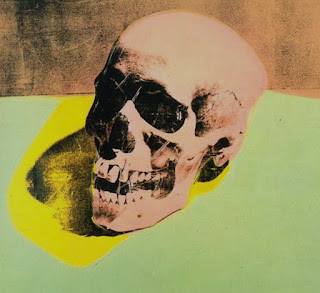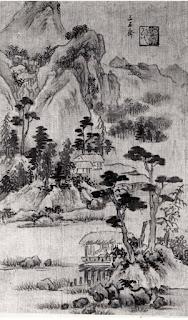Baroque
 |
| “Saint Jerome Writing By Caravaggio” |
When it comes to art work, I find myself more drawn to the darker pieces. I immediately fell in love with Caravaggio’s painting Saint Jerome Writing, also called Saint Jerome in His Study or simply Saint Jerome. He created this oil painting in 1605-1606 and is found in the Galleria Borghese in Rome. The background of this painting is about St. Jerome, a doctor of the church. In the painting he is seen studying the Sacred Scriptures which, according to tradition, he translated from Greek to Latin. I love how simplistic the art is but also still eye catching. This is an art piece you can see from across the room from how much contrast it has. It shows two large fields of color. Warm tones - such as the skin of the Saint and the mantle, and cold tones- the skull and the white cloth standing out against the open book. It portrays a dialogue between life and death and past and present. I think that’s one reason why I love this piece so much. To me art doesn’t need to be so in your face, it can be something simple and dark but still evokes emotion. This painting makes me feel a sense of longing. You see him hunched over with a huge book in his hands, while writing with the other. The use of the color red makes it seem like he’s someone important and respected. That what he’s doing is important but also taking a huge toll on himself, making him extremely tired.
During my research on Caravaggio, I read a lot about how many described him as violent. That made me immediately think of the Thirty Year War. Even though I couldn’t find if he was apart of the war. His passion and intention of his painting are mirrored by his violent and turbulent lifestyle. When Caravaggio was a child, he lost both his parents to bubonic plague. He moved to Rome and started selling his paintings. Once he started making a name for himself, he started getting into trouble. He became known for his drinking, gambling, sward-carrying, and brawling. he eventually fled Rome after killing a man. The Thirty Year War was a religious conflict that lasted from 1618 to 1648. It had more than eight million casualties. Another reason I connected Caravaggio to the Thirty Year War, besides his own violence, is because some of Caravaggio’s paintings included a lot of religious figures.
Caravaggio, Author: “Saint Jerome Writing by Caravaggio.” Galerie Borghèse, 22 Nov. 2023, borghese.gallery/collection/paintings/saint-jerome-writing.html.
Caravaggio: The Italian Painter Was Also a Notorious Criminal And ..., www.biography.com/artists/caravaggio-italian-painter-criminal-murderer. Accessed 29 Feb. 2024.



It seems Caravaggio was also a student of the Renaissance and humanism. Despite being a Christian character, Saint Jerome is depicted wearing a robe in the Greek style and seems emaciated rather than idealized. The tenebrism is probably what defines the Caravaggio style, as it lets him add subtle details like the dark halo above Jerome's head.
ReplyDeleteThe act of drawing dramatic religious imagery also connects Caravaggio to the Thirty Year's War because that was a trademark of the Catholic counter-reformation, and the war was based largely in religion. I would argue that the skull, and maybe even the cloth, don't have the coldness you're ascribing to them. The skull is a soft brown-white, not a sharp cold white. I agree, however, that this piece does an excellent job of evoking emotion in simple imagery.
This comment has been removed by the author.
ReplyDeleteHi! I was also drawn to Caravaggio's distinctly darker style, with many of his works involving death of some kind. Whether it be the Crucifixion of St Peter (the piece I covered) or Judith Slaying Holofernes that directly shows someone being killed, or even this piece which shows a human skull; all of them in extremely photo-realistic detail that had not been seen before. I had no idea that he killed a man and had such violent tendencies, which now upon learning this explains Caravaggio's very intense and personal style. (Previous comment sited wrong painting by accident)
Deletehello!, When i look at this the first thing that caught my eye was actually the skull on the table, rather than the person sitting in the chair. To me this feels like it was a sense of battling against yourself. His darkish style kind of reminds me of gothic art. I love his style and color tones that you have described and seeing a different perspective of what i saw.
ReplyDeleteI think that Caravaggio used the differing colors to aid in pointing out the line between life and death. The use of red draped around a seemingly frail man to me depicts the importance of the man and the task at hand (translating scripture). The frailness of the man depicts the toll it takes on human life. Even though he is obviously writing its almost as if he his reaching out for death with his hand stretched out towards the skull.
ReplyDeleteI love Caravaggio's works as well! The way Caravaggio uses tenebrism to depict the mortality and grievances of the people in his works is wonderful. When he pairs the contrast of light and dark with the differences between vibrant the colors (like the red toga and brown of the books and table) and his paintings really come to life. I find it easy to believe that he was a violent man, as I think only someone like that could bring to life the kinds of painting he made. I'm sure that whether he was a part of the thirty year war or not, it was something that inspired some of his works.
ReplyDeleteI too love the darker pieces! I chose one of Caravaggio's works as my piece as well as he often utilizes tenebrism. I find it interesting how you related Caravaggio's violent tendencies to the thirty year war as I never connected that myself. I remember reading he was even arrested at one point. Caravaggio seemed to be very involved with religion, and on multiple occasions he was commissioned by various churches and chapels. I wonder if Caravaggio himself or his works had any influence on starting the thirty year war. Great post by the way!
ReplyDelete